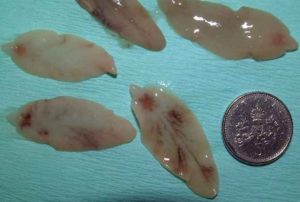Liver fluke infection in cattle
Liver fluke (Fasciola hepatica) is a leaf-shaped parasite which lives in the liver and bile ducts of infected cattle. Sheep, rabbits, deer and horses can also host the parasite.
The liver fluke life cycle involves a free-living stage which depends on the presence of an intermediate host, a mud snail. The seasonal nature of liver fluke infection results from infective larvae being shed by snails onto pasture primarily during late summer and early autumn. Cattle grazing over the autumn are at risk of ingesting larvae over a prolonged period and developing chronic disease which becomes evident in late winter and early spring.
With the effects of infection on growth rate and milk yield estimated to cost the UK cattle industry up to £40.4 million annually, effective and sustainable parasite control within herds is essential. A multidisciplined approach involving strategic flukicide product choice to reduce pasture contamination and drug resistance, alongside pasture management to restrict cattle access to snail habitats and quarantine of new stock with unknown infection status is recommended.
